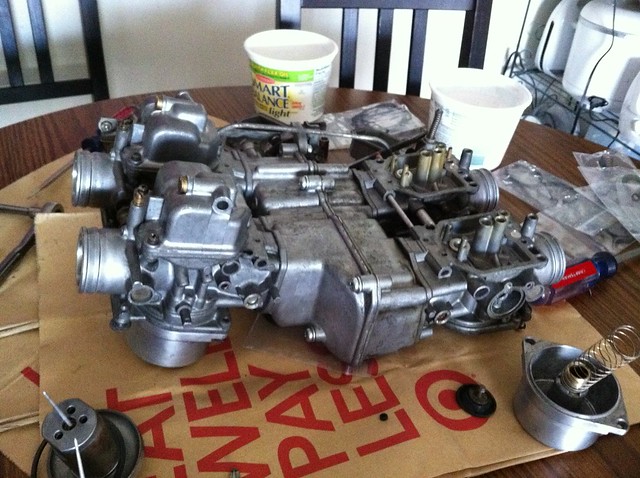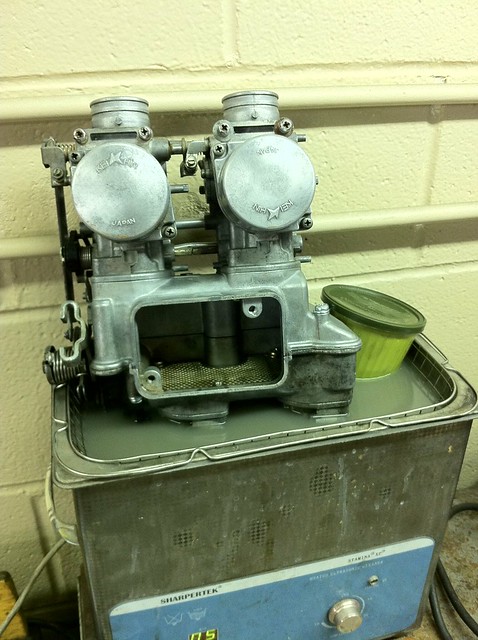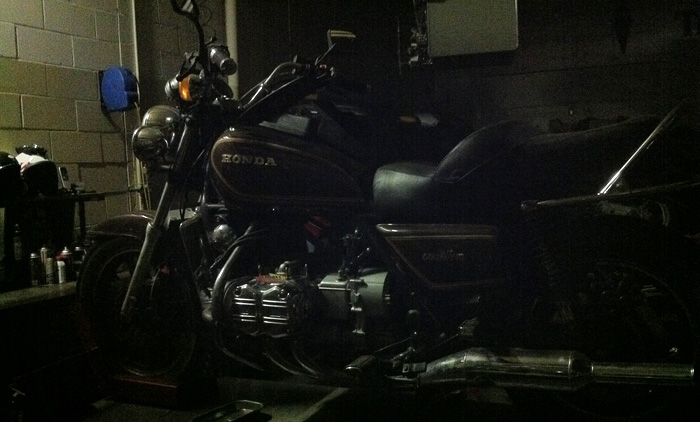It’s no secret inside the walls of BlueCat Motors that my ambitions tend to far outpace both the time at hand and any sort of moderate good sense. I wanted one of everything that rolled through the door and three of some things. That, and I want to do it all myself. I want to go to bed every night smelling vaguely of either the wind and road, or of grease, petrol and industrial-strength solvents. I don’t like it if the creases in my fingerprints get too clean. It’s a good thing I don’t mind getting over my head in a bike project though. I own an old Goldwing after all. If I’m not over my head, I’m going to be at least elbow deep.
My first experience working on my 1983 Honda GL1100 had definitely driven home the point that I was in for it. While my brief time riding the old sled had convinced me that I’d made the right choice, I knew I’d be putting in some sweat equity before the GL was road worthy, let alone as special as I hoped to make it. Jeff and I had given the bike a thorough going over. It needed brake pads. It needed a rear rotor. It needed tires. It needed a brake system bleed and a hundred other little things. I put in an order of parts with the front desk and the wait began. Jeff and I spent subsequent Moto Dojo evenings tearing into my CB450. Parts began to trickle in about three weeks later. Pads. Master cylinder rebuild kits. One of the two tires. Caliper rebuild kits. I’d been ordering off menu as well — grabbing some items from Randakk’s Goldwing tuning catalog. I’d picked up his spin-on oil filter conversion kit, but most importantly, I’d purchased his comprehensive carburetor rebuild kit. The GL didn’t start as readily as I’d like, so like many other things on the bike, I wanted to start from scratch and know first hand that the carbs were as clean and properly balanced as possible.
If there’s any one system that exemplifies the complication of the GL1100, it’s the carburetor setup. The GL’s four cylinders are each fed by a dedicated Keihin constant velocity carburetor. Two banks of two carb are joined in the center by a plenum chamber that then faces upward to receive the airbox, which sits inside the false gas tank enclosure (the real gas tank is under the seat). Around the perimeter of the carbs are four manifolds that reach down into each cylinder. On the rear end of the whole assembly is a clockwork throttle and choke assembly that I can’t even begin to describe. Suffice it to say there are more moving parts in just the throttle assembly on the GL than in the whole engine of some simpler motorcycles. The whole assembly sits on top of the engine like some kind of art deco oil rig. The rebuild kit is more than 120 pieces — gaskets, o-rings of different profiles and brass pieces.

Thing is, by this point I was over carburetors. All the mystery was gone. It’s a toilet. A carb is just a float and some plumbing. No big deal. My employer at the time was having payroll issues and wasn’t paying us on time. So on those days when I was waiting for a check, (because I don’t work for free and neither should you) I’d go over to the shop and do whatever basic mechanic work Jeff needed done around the shop. This included fork seals, summerization, and several carb rebuilds. Between those carbs I did for Jeff and the rebuilds I’d already done on the CM400 and CB450, I figured the carbs on the GL would be no problem.
Per usual, I was wrong. Very, very wrong.
To pull, clean, test and reassemble the carb rack on an inline four-cylinder motorcycle takes me somewhere between two and four hours depending on the bike. I figured four cylinders is four cylinders, right? So I scheduled an evening working session with Jeff to get this carb clean started. I had haughty aspirations, as usual. I was old hat at this stuff by then, in my mind. Two hours in and I had only just got the rack free from the bike. I’d managed not to break anything, but just barely. With the whole assembly now in hand, I went against Jeff’s advice and cracked the plenum. This meant disconnecting several parts of the throttle assembly and unbolting the two halves of the plenum. Furthermore, I was determined to have all four carburetors off the bike and separated. I had new rubber for every nook and cranny of this carburetor assembly and I would not be denied. I was going to use every last piece of it. Plus, I’d just dealt with leaking o-rings in the fuel sharing passages in the CM400. They’d dried out, gone hard and made the carburetors leak something awful.
Getting the carburetors out of the GL was enough of an ordeal that I wasn’t going to do all this work just to leave old rubber between the carbs to leak and force me to haul them back out and take them apart again anyway. Four hours of work that first night and I’d only managed to free two carbs and get them through the ultrasonic cleaner. That was my soonest stopping point. it was nearly 11:00 pm. I felt like I was genuinely in the way at that point and like I’d really overstayed my welcome. Jeff and Ryan were both gracious about the whole thing, like always, but this was not the right way to do this. It wasn’t fair to them, and frankly, it wasn’t fun having to rush through the work like that.
I threw in the towel, bagged up all my parts and went home. With a better understanding of just how much work I was in for, I came back the next day and grabbed all my carb components and the other half of the rack. I’d finish this job at home, at my own pace, and well out of Jeff’s way. Then I’d bring everything back for reassembly. With the parts spread out over my kitchen table (yeah, I was that guy and I loved it) I began methodically and carefully disassembling the other half of the rack.

It would be seven more hours of work over the next week before I got the GL’s carbs fully cleaned and reassembled. A job that I predicted would take at most four hours, had taken me eleven hours! What’s more, the carbs weren’t even reinstalled yet. I understood fully then what Jeff meant when he said he could never make money working on Goldwings. Now that I know how to do it, I could probably do the job in, at best, about six hours. Nobody is going to pay six hours of labor to clean the carbs on a 30 year-old motorcycle. You’d have to charge at east $750 to make any money on it. Thankfully for me though, it was satisfying work. I’d taken on a truly expert level carburetor project and come out on top. Well, sort of.

In my exuberance, as is so often the case, I neglected one very important step. I didn’t “bench test” the carbs. Bench testing is a simple little procedure where you hook up the carb or carbs to a fuel source. We called ours “the baby bottle” because that’s what it looks like. You let the bowls fill with fuel and you check for two things. Does the accelerator pump work? Are there any leaks? If you neglect this step, you might get lucky. You might be able to reinstall the carbs and have no trouble at all. But more likely than not, you’re setting yourself up for a bunch of extra work. In my case, I hadn’t left it out on purpose, I’d just gotten excited. I was so proud of my rebuild that I went straight to reinstalling the carbs in the GL. My exuberance soon giving way to pure hubris — thinking that I’d done everything right and there was no way there’d be any issues. I got everything installed, and turned on the gas. The bike fired up pretty nicely. The idle mixture screws were set where I’d found them, which was about half a turn lean from stock. But the machine ran. It was satisfying. That is, until the smell of gasoline got really strong. I poked my flashlight under the rack and sure enough, it was leaking fuel.
“You didn’t bench test it did you?” Jeff asked me knowingly.
Finishing this job would have to wait for yet another day when I could swing by the shop. The GL was in back by this point. Ryan had left me a little corner where I could park my butt and my tools and work on the Goldwing during business hours. I know it was in trade for all the writing I was doing for them, but I still appreciated how much access the boys gave me to their shop.
It would be at least a week before I could return and yank the carbs back off the bike and figure out what was wrong. I spent two hours bench testing floats, valves, and o-rings. I was finally able to deduce that it was one of the fuel sharing passages between the plenum and the #3 carburetor that was leaking. Digging through the options of available o-rings in the remnants of the Randakk kit, I finally realized which o-ring I was missing and where. My bench test finally succeeded and I set about installing the carbs one (hopefully) last time. With the throttle cables hooked back up (have I mentioned how much I hate throttle cables?) all the clamps in place and the airbox bolted back onto the plenum, it was time to try the old boy one more time. Fuel on, and no leaks. That’s a good jumping off point. I pulled in the clutch and hit the starter button. The beast fired to life — this time keeping all its vital fluids where they belonged. Robb was just on his way out when the GL finally fired up. I couldn’t not call attention to it. I was proud of myself, and rightfully so. I wanted anybody who was around to see what nearly 18 hours of work had finally wrought: a bike that ran.
Sweaty and exhausted from crawling around under the bike for four hours, there was just one thing left to do. I was going to ride this motorcycle. Nevermind that I didn’t have a helmet with me. Nevermind that the brakes were part pneumatic they had so much air in the lines. Nevermind the shitty chinese tires. Nevermind that I was tired. There needed to be an expression of all the work that had gone into getting this machine to where it was. I would ride the horse I’d just tamed, even if just up the block and back.
I threw a leg over and pulled out into the parking lot. The shop had just closed for the day and Ryan and Rumpal were enjoying an after work smoke in the open garage door. I pulled away somewhat gingerly, and headed south on Prior Ave. Opening the bike up into second and then third gear. Even though the carbs were clean and free of leaks, they still weren’t sync’d yet. The bike pulled well, but wasn’t as smooth as I knew it would be once all four carbs were in sync.
I went about half a mile then pulled a u-turn. The brakes felt like they were made out of Nerf rubber. They might as well have been tired old drum brakes as three disks clamped by duel piston calipers. Brakes were another job, for another day, though.
Heading back, it was time to buzz the tower. I let out a few jabs of the horn to let the guys know I was coming. Just as BlueCat came into view, I screwed the throttle all the way. What happened next was surreal. The bike roared to life and the engine spun up like some kind of steam-powered jet turbine. My adrenaline kicked in and for an instant everything was in slow motion. I saw the street and surrounding buildings stretch and elongate toward the vanishing point in the horizon ahead. My vision blurred — my eyes naked in the wind. And as that second of slow motion ended, and time snapped back into place, the bike and I shot forward like the Millennium Falcon making the jump to light speed. It was exhilarating. It was gratifying. It was terrifying in all the best ways. The wind howled and the engine roared. For an instant, I almost thought that if I pulled up on the handlebars, the old boy just might fly. The Kessel Run would have to wait, though. This thing barely had any brakes, so I figured I’d better start slowing down before I careened out of control into the intersection of Prior and University. As quickly as I’d burst forward, I started slowing down.
Thankfully the bike did, in fact, slow down under control. I made one last u-turn and headed back to BlueCat Motors. There was more work to be done on the GL, but for now, I’d accomplished a big part of what I’d set out to do on this machine. I was wiser, too, if no less ambitions.
![]()

Leave A Comment